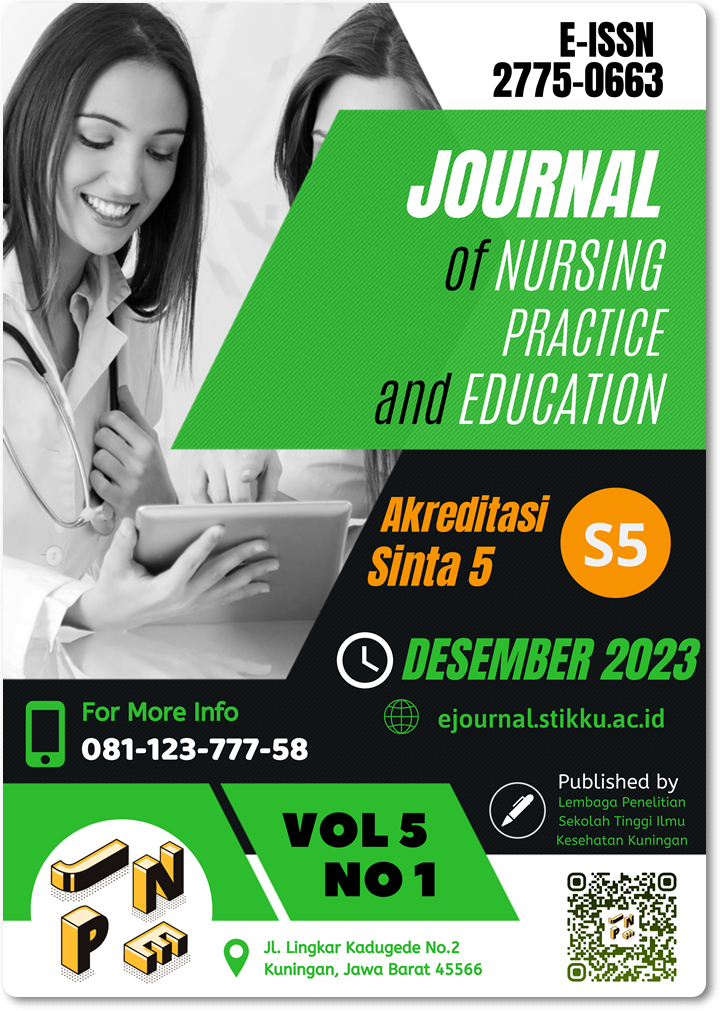Hubungan antara karakteristik sosial dan ekonomi dengan prevalensi kesehatan mental di Indonesia
DOI:
https://doi.org/10.34305/jnpe.v5i1.1412Keywords:
Kesehatan mental, karakteristik sosial, karakteristik ekonomi, prevalensi masalah kesehatan mental, kesehatanAbstract
Latar Belakang: Masalah kesehatan mental semakin menjadi perhatian global, termasuk di Indonesia. Data menunjukkan bahwa prevalensi masalah kesehatan jiwa terus meningkat, dengan dampak signifikan terhadap individu dan masyarakat. Penelitian ini berfokus pada hubungan antara karakteristik sosial dan ekonomi dengan prevalensi masalah kesehatan mental di Indonesia pada tahun 2023.
Metode: Penelitian ini menggunakan pendekatan kuantitatif dengan desain cross-sectional, menganalisis data sekunder dari Survei Kesehatan Indonesia (SKI) 2023. Sampel terdiri dari 1.000 responden berusia 15 tahun ke atas. Analisis dilakukan menggunakan uji Chi-Square.
Hasil: Hasil analisis menunjukkan bahwa terdapat hubungan signifikan antara kelompok umur dan prevalensi masalah kesehatan mental (χ² = 77.85, p = 0,001). Namun, tidak ditemukan hubungan signifikan antara jenis kelamin (χ² = 0.99, p = 0.320), pendidikan (χ² = 2.778, p = 0.751), pekerjaan (χ² = 2.632, p = 0.90), tempat tinggal (χ² = 0.6362, p = 0.425), dan status ekonomi (χ² = 0.3620, p = 0.98).
Kesimpulan: Penelitian ini menjelaskan pentingnya mempertimbangkan kelompok umur dalam upaya penanganan masalah kesehatan mental, sementara faktor-faktor sosial dan ekonomi lainnya tidak menunjukkan hubungan signifikan namun tetap berpotensi berkontribusi terhadap pemahaman yang lebih luas mengenai kesehatan mental.
References
Altwaijri, Y. A., Al‐Subaie, A. S., Al‐Habeeb, A., Bilal, L., Al‐Desouki, M., Aradati, M., King, A. J., Sampson, N. A., & Kessler, R. C. (2020). Lifetime prevalence and age‐of‐onset distributions of mental disorders in the Saudi National Mental Health Survey. International Journal of Methods in Psychiatric Research, 29(3), 1836. https://doi.org/https://doi.org/10.1002/mpr.1836
Badan Kebijakan Pembangunan Kesehatan. (2023). Survei Kesehatan Indonesia Tahun 2023. TIM PENYUSUN SKI 2023.
Jacobi, F., Höfler, M., Siegert, J., Mack, S., Gerschler, A., Scholl, L., Busch, M. A., Hapke, U., Maske, U., & Seiffert, I. (2014). Twelve‐month prevalence, comorbidity and correlates of mental disorders in Germany: the Mental Health Module of the German Health Interview and Examination Survey for Adults (DEGS1‐MH). International Journal of Methods in Psychiatric Research, 23(3), 304–319. https://doi.org/10.1002/mpr.1439
Kemenkes RI. (2013). Riset Kesehatan Dasar 2013. Kementrian Kesehatan RI.
Kemenkes RI. (2018). Riset Kesehatan Dasar 2018. Kementrian Kesehatan RI.
Kondirolli, F., & Sunder, N. (2022). Mental health effects of education. Health Economics, 31, 22–39. https://doi.org/https://doi.org/10.1002/hec.4565
Lawrance, E. L., Thompson, R., Newberry Le Vay, J., Page, L., & Jennings, N. (2022). The impact of climate change on mental health and emotional wellbeing: a narrative review of current evidence, and its implications. International Review of Psychiatry, 34(5), 443–498. https://doi.org/https://doi.org/10.1080/09540261.2022.2128725.
Macintyre, A., Ferris, D., Gonçalves, B., & Quinn, N. (2018). What has economics got to do with it? The impact of socioeconomic factors on mental health and the case for collective action. Palgrave Communications, 4(1), 1–5. https://doi.org/https://doi.org/10.1057/s41599-018-0063-2
Mojtabai, R., & Olfson, M. (2020). National trends in mental health care for US adolescents. JAMA Psychiatry, 77(7), 703–714. https://doi.org/https://doi.org/10.1001/jamapsychiatry.2020.0279
National Institute of Mental Health. (2024). Depression. https://www.nimh.nih.gov/health/topics/depression
Otten, D., Heller, A., Schmidt, P., Beutel, M. E., & Brähler, E. (2024). Gender differences in the prevalence of mental distress in East and West Germany over time: a hierarchical age-period-cohort analysis, 2006–2021. Social Psychiatry and Psychiatric Epidemiology, 59(2), 315–328. https://doi.org/https://doi.org/10.1007/s00127-023-02479-z
Reuben, A., Manczak, E. M., Cabrera, L. Y., Alegria, M., Bucher, M. L., Freeman, E. C., Miller, G. W., Solomon, G. M., & Perry, M. J. (2022). The interplay of environmental exposures and mental health: setting an agenda. Environmental Health Perspectives, 130(2), 1–11. https://doi.org/https://doi.org/10.1289/EHP9889
Silva, M., Resurrección, D. M., Antunes, A., Frasquilho, D., & Cardoso, G. (2018). Impact of economic crises on mental health care: a systematic review. Epidemiology and Psychiatric Sciences, 29(7), 1–13. https://doi.org/https://doi.org/10.1017/S2045796018000641
Sukesi, T. W., Sulistyawati, S., Khair, U., Mulasari, S. A., Tentama, F., Ghazali, F. A., Yuliansyah, H., & Sudarsono, B. (2023). Hubungan antara Kesehatan Lingkungan dengan Gangguan Emosional. Jurnal Kesehatan Lingkungan Indonesia, 22(2), 128–133. https://doi.org/https://doi.org/10.14710/jkli.22.2.128-133
Viana, M. C., & Andrade, L. H. (2012). Lifetime prevalence, age and gender distribution and age-of-onset of psychiatric disorders in the São Paulo Metropolitan Area, Brazil: results from the São Paulo Megacity Mental Health Survey. Brazilian Journal of Psychiatry, 34(3), 249–260. https://doi.org/https://doi.org/10.1590/S1516-44462012000300011
Waechter, R., Gallant, C., De Wilde, K., Arens, G., Brady, T., Custodio, J., Wakita, Y., Landon, B., Boateng, Y., & Parthab, N. (2023). Prevention of mental illness within public health: An analysis of progress via systematic literature review and a pathway forward. Preventive Medicine Reports, 34, 102249. https://doi.org/https://doi.org/10.1016/j.pmedr.2023.102249
WHO. (2022). Mental health. World Health Organization. https://www.who.int/news-room/fact-sheets/detail/mental-health-strengthening-our-response/?gad_source=1&gclid=CjwKCAjwg-24BhB_EiwA1ZOx8r54MtH_7_A7BKt_ap-mtxgMrZrGNp_WyN-6fOsOOczWSEbp_BVMFRoCFfMQAvD_BwE
Downloads
Published
How to Cite
Issue
Section
License
Copyright (c) 2024 Heri Hermansyah, Astryanike Rauntu

This work is licensed under a Creative Commons Attribution 4.0 International License.
Journal of Nursing Practice and Education published under the terms of a Creative Commons Attribution 4.0 International License / CC BY 4.0 This license permits anyone to copy and redistribute this material in any form or format, compose, modify, and make derivative works of this material for any purpose, including commercial purposes, so long as they include credit to the Author of the original work.
This work is licensed under a Creative Commons Attribution 4.0 International License / CC BY 4.0





